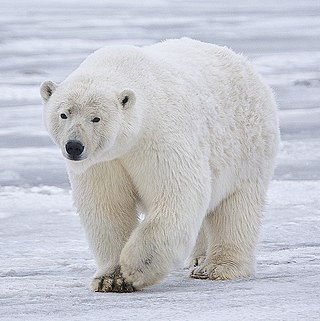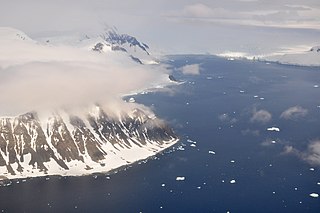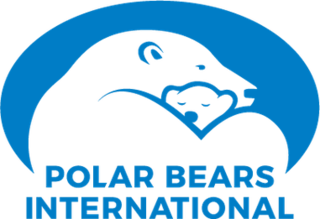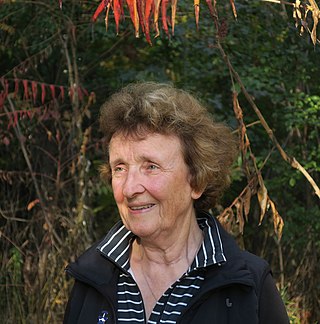Related Research Articles

The polar bear is a large bear native to the Arctic and nearby areas. It is closely related to the brown bear, and the two species can interbreed. The polar bear is the largest extant species of bear and land carnivore, with adult males weighing 300–800 kg (660–1,760 lb). The species is sexually dimorphic, as adult females are much smaller. The polar bear is white- or yellowish-furred with black skin and a thick layer of fat. It is more slender than the brown bear, with a narrower skull, longer neck and lower shoulder hump. Its teeth are sharper and more adapted to cutting meat. The paws are large and allow the bear to walk on ice and paddle in the water.

The Arctic is a polar region located at the northernmost part of Earth. The Arctic region, from the IERS Reference Meridian travelling east, consists of parts of northern Norway, northernmost Sweden, northern Finland, Russia, the United States (Alaska), Canada, Danish Realm (Greenland), and northern Iceland, along with the Arctic Ocean and adjacent seas. Land within the Arctic region has seasonally varying snow and ice cover, with predominantly treeless permafrost under the tundra. Arctic seas contain seasonal sea ice in many places.

Marine mammals are mammals that rely on marine (saltwater) ecosystems for their existence. They include animals such as cetaceans, pinnipeds, sirenians, sea otters and polar bears. They are an informal group, unified only by their reliance on marine environments for feeding and survival.

The ringed seal is an earless seal inhabiting the Arctic and sub-Arctic regions. The ringed seal is a relatively small seal, rarely greater than 1.5 m in length, with a distinctive patterning of dark spots surrounded by light gray rings, hence its common name. It is the most abundant and wide-ranging ice seal in the Northern Hemisphere, ranging throughout the Arctic Ocean, into the Bering Sea and Okhotsk Sea as far south as the northern coast of Japan in the Pacific and throughout the North Atlantic coasts of Greenland and Scandinavia as far south as Newfoundland, and including two freshwater subspecies in northern Europe. Ringed seals are one of the primary prey of polar bears and killer whales, and have long been a component of the diet of indigenous people of the Arctic.

The Canadian Wildlife Service or CWS, is a Branch of the Department of Environment and Climate Change Canada, a department of the Government of Canada. November 1, 2012 marked the 65th anniversary of the founding of Service.

Arctic ecology is the scientific study of the relationships between biotic and abiotic factors in the arctic, the region north of the Arctic Circle. This region is characterized by two biomes: taiga and tundra. While the taiga has a more moderate climate and permits a diversity of both non-vascular and vascular plants, the tundra has a limited growing season and stressful growing conditions due to intense cold, low precipitation, and a lack of sunlight throughout the winter. Sensitive ecosystems exist throughout the Arctic region, which are being impacted dramatically by global warming.

Katey M. Walter Anthony is an Alaskan aquatic ecologist and biogeochemist researching carbon and nutrient cycling between terrestrial and aquatic systems, and the cryosphere and atmosphere.

Pagophily or pagophilia is the preference or dependence on water ice for some or all activities and functions. The term Pagophila is derived from the Ancient Greek pagos meaning "sea-ice", and philos meaning "-loving".
Mitchell Taylor is a Canadian biologist specializing in polar bears who claims that Canada's polar bear population is higher now than it was 30 years ago and that polar bears are not currently threatened by climate change. He is currently a contract adjunct professor at Lakehead University, and he is affiliated with the Heartland Institute.

Bernard Stonehouse was a British scientist who specialised in animal behaviour, polar research and popular science. In 1953 he received the Polar Medal.

There are many effects of climate change on oceans. One of the main ones is an increase in ocean temperatures. More frequent marine heatwaves are linked to this. The rising temperature contributes to a rise in sea levels due to melting ice sheets. Other effects on oceans include sea ice decline, reducing pH values and oxygen levels, as well as increased ocean stratification. All this can lead to changes of ocean currents, for example a weakening of the Atlantic meridional overturning circulation (AMOC). The main root cause of these changes are the emissions of greenhouse gases from human activities, mainly burning of fossil fuels. Carbon dioxide and methane are examples of greenhouse gases. The additional greenhouse effect leads to ocean warming because the ocean takes up most of the additional heat in the climate system. The ocean also absorbs some of the extra carbon dioxide that is in the atmosphere. This causes the pH value of the seawater to drop. Scientists estimate that the ocean absorbs about 25% of all human-caused CO2 emissions.
Steven C. Amstrup is an American zoologist who studies bears, especially polar bears. He is the 2012 recipient of the Indianapolis Prize.

Polar Bears International (PBI) is a non-profit polar bear conservation organization. Their research, education, and action programs address the issues that are endangering polar bears. The organization also studies polar bears and monitors their activity data which helped lead to the animals being listed as a threatened species. While Churchill, Canada, serves as an important hub for PBI scientists and educators, the organization's work on behalf of polar bears spans the Arctic including Svalbard, Russia, and Alaska.

The North Water Polynya (NOW), or Pikialasorsuaq to Inuit in Greenland and Sarvarjuaq to Inuit in Canada, is a polynya that lies between Greenland and Canada in northern Baffin Bay. The world's largest Arctic polynya at about 85,000 km2 (33,000 sq mi), it creates a warm microclimate that provides a refuge for narwhal, beluga, walrus, and bowhead whales to feed and rest. While thin ice forms in some areas, the polynya is kept open by wind, tides and an ice bridge on its northern edge. Named the "North Water" by 19th century whalers who relied on it for spring passage, this polynya is one of the most biologically productive marine areas in the Arctic Ocean.
Kit Kovacs is a marine mammal researcher, best known for her work on biology, conservation and management of whales and seals. She is based at the Norwegian Polar Institute (NPI), Tromsø and is an Adjunct professor of biology, Marine Biology, at the University Centre in Svalbard (UNIS).

Kathy Martin is a Canadian ornithologist who is an expert on arctic and alpine grouse and ptarmigan, and on tree cavity-nesting vertebrates. She is a professor in the Faculty of Forestry at the University of British Columbia and was a senior research scientist with Environment and Climate Change Canada.
Susan Janet Crockford is a Canadian contract scientist who runs a small business identifying bones and other items in scat of wildlife. She is a blogger who writes about zoology and climate science, specializing in Holocene mammals. From 2004 to 2019 she was an adjunct professor in Anthropology at the University of Victoria. She is known for her blog posts on polar bear biology, which are unsupported by the scientific literature and oppose the scientific consensus that polar bears are threatened by ongoing climate change.

Jennifer F. Provencher is a Canadian conservation biologist. She is an early-career researcher and a spokesperson for the awareness of plastic contaminants in marine wildlife, pollution and climate change. Many of her work focus on the impact of human activities on the health of Arctic seabirds and marine ecosystems.
Roxane Maranger is a professor at Université de Montréal and Canada Research Chair Tier I in Aquatic Ecosystem Science and Sustainability known for her research on the impact of humans on water quality in lakes. From July 2020 - July 2022, she served as the president of the Association for the Sciences of Limnology and Oceanography (ASLO).

Polar bear population sizes and trends are difficult to estimate accurately because they occupy remote home ranges and exist at low population densities. Polar bear fieldwork can also be hazardous to researchers. As of 2015, the International Union for Conservation of Nature (IUCN) reports that the global population of polar bears is 22,000 to 31,000, and the current population trend is unknown. Nevertheless, polar bears are listed as "Vulnerable" under criterion A3c, which indicates an expected population decrease of ≥30% over the next three generations due to "decline in area of occupancy, extent of occurrence and/or quality of habitat". Risks to the polar bear include climate change, pollution in the form of toxic contaminants, conflicts with shipping, oil and gas exploration and development, and human-bear interactions including harvesting and possible stresses from recreational polar-bear watching.
References
- 1 2 3 4 "Kenneth S. Norris Lifetime Achievement Award". Marine Mammal Science. 32 (1): 10–12. 2016. doi:10.1111/mms.12294. ISSN 0824-0469.
- ↑ "The Council of Science Editors (CSE) - 2007 Annual Meeting". Councilscienceeditors.org. Archived from the original on April 3, 2008.
{{cite web}}: CS1 maint: unfit URL (link) - ↑ "CBC News Indepth: Polar Bears". Cbc.ca. 6 July 2004. Archived from the original on October 12, 2007.
{{cite web}}: CS1 maint: unfit URL (link) - ↑ Post, Eric; Forchhammer, Mads C.; Bret-Harte, M. Syndonia; Callaghan, Terry V.; Christensen, Torben R.; Elberling, Bo; Fox, Anthony D.; Gilg, Olivier; Hik, David S.; Høye, Toke T.; Ims, Rolf A.; Jeppesen, Erik; Klein, David R.; Madsen, Jesper; McGuire, A. David (2009-09-11). "Ecological Dynamics Across the Arctic Associated with Recent Climate Change". Science. 325 (5946): 1355–1358. doi:10.1126/science.1173113. ISSN 0036-8075.
- ↑ Grote, Stirling, Ian (1 January 1965). Studies of the holding, behaviour and nutrition of captive blue grouse (Thesis). University of British Columbia. doi:10.14288/1.0302522. hdl:2429/37452.
{{cite thesis}}: CS1 maint: multiple names: authors list (link) - ↑ Stirling, Ian (1968). Population ecology of the Weddell seal (Leptonychotes weddelli) in McMurdo Sound, Antarctica (Doctoral thesis). UC Research Repository, University of Canterbury. doi:10.26021/6015. hdl:10092/6646.
- ↑ Stirling, Ian; Derocher, Andrew E. (1993). "Possible impacts of climatic warming on polar bears". Arctic. 46 (3). Arctic Institute of North America: 240–245. doi: 10.14430/arctic1348 .
- ↑ "TheStar.com - Arctic In Peril - Polar bear population on thin ice". Thestar.com. 26 November 2007. Archived from the original on April 3, 2008.
{{cite web}}: CS1 maint: unfit URL (link) - 1 2 "Scientist Ian Stirling Receives Ice Bear Lifetime Achievement Award | Polar Bears International". polarbearsinternational.org. Retrieved 2024-05-18.
- ↑ "Polar Bear Range States - Ian Stirling - Conservation Award Winner 2020". polarbearagreement.org. Retrieved 2024-05-18.
- ↑ "Weston Family Prize for Lifetime Achievement in Northern Research - ACUNS/AUCEN: Association of Canadian Universities for Northern Studies / Association universitaire canadienne d'études nordiques". Acuns.ca. Retrieved 2016-07-08.
- ↑ "Society for Marine Mammalogy". Marinemammalscience.org. Retrieved 2016-07-08.
- ↑ "Dr. Ian Stirling, O.C. - Graduation at UBC". Graduation.ubc.ca. Retrieved 2016-07-08.
- ↑ "Arctic champion receives honorary degree". www.ualberta.ca. Retrieved 2024-05-18.
- ↑ "Mr. Ian Grote Stirling". The Governor General of Canada. Retrieved 2024-05-18.